Incorporating slowmovingvehicle.science , safety.graphics, farmsafety.design, safety.ag and amish.technology
—NEW— Police, truckers and motorists awareness survey. Please participate if you have seen these triangles in use on the backs of any Amish buggies. Click here
(Owing to new YouTube video linking anomalies, please click the “Watch It On YouTube” options if this video’s playback fails to load. Then come back to the rest of this post and site.)
And now a new development: Bigger is Better (link)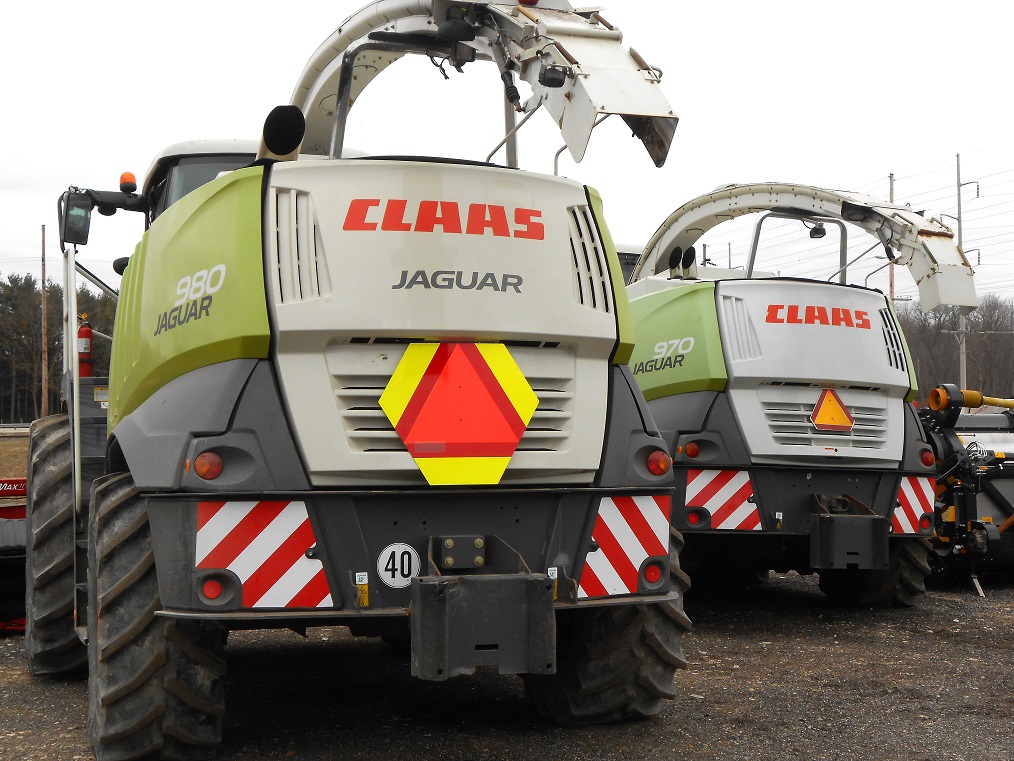
From Safety Psychographics…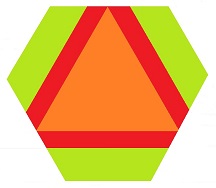
Using “visual psychographics” scientifically for safety |
APPLIED PSYCHOGRAPHICS comes to the aid of farmers, motorists and the Amish
The Tri-Color Triangle ™ is a dramatic, copyrighted and now patented conspicuity upgrade to the 50-year-old SMV emblem, differing from that because it has a third, high-visibility color that is more visible day and night, plus the center fluorescent orange section is also newly-retro-reflective at night. Added fluorescent-AND-retro-reflective yellow-green stripes (see patent/copyright information) and their contrast with the existing standard colors is more visually-arresting both day and night, and, coupled with the center section’s new-found retro-reflectivity, makes this emblem much more visible at night, plus it now at last appears the same at night as it does by day. Using scientifically-proven fluorescent/retro-reflective yellow-green outer stripes with their increased overall area gives the old SMV emblem a much-needed 3-way upgrade in order to stand out to inattentive motorists in today’s higher-speed traffic. Yellow-green of 0.555 micrometer wavelength is the color most stimulating to the eye and its use here finally gives much-needed contrast to the existing orange and red for a safer total visual effect.
Why reinvent the venerable “tractor triangle?”
Quotes from one in the know:
“While attaining widespread use and institutional acceptance in its (50) years on the road, crash data indicate that the slow-moving vehicle (SMV) emblem may not be meeting the safety needs of either the motoring public or SMV operators. (The article excerpted here) addresses the possibility that the reasons for this include its inconsistent day/night appearance, potential confusion with other roadway symbols, its uncontrolled misuse, and poor driver education.” From the article’s conclusions: “… and perhaps emblem modification (is needed) to make it more iconic* in nature or at least to ensure that it appears the same to approaching drivers in daylight and at night.“ —Excerpted from an article in the Journal of Agricultural Safety and Health (published by the ASABE), “Motorist Comprehension of the Slow Moving Vehicle Emblem” by P. M. Garvey… the full text of which can be accessed by members and non-members at this address (link); non-members must pay for access.
(*the T-C T’s modifications stay in the realm of “symbolic” vs. “iconic” by definitions in the article)
Additional quotes from “Farm Tractors — A Living History”:
“But people are often cautious and sometimes cruel toward new ideas. Where a farmer appeared with (then-brand new) rubber tires on his tractor working the field, neighbors stood at the fence and called him ‘sissy’…. To placate the conservative farmers, steel wheels were still optional up through 1940….”
“No sooner was the safety issue (of rollover protection–Deere Roll-Gard) addressed than concern over slow-moving vehicles surfaced. The Automotive Safety Foundation, monitoring the numerous rear-end accidents in which fast-moving automobiles hit slow-moving tractors, funded the creation and subsequent standardization of the fluorescent orange triangle, developed at Ohio State University by agricultural engineering graduate student Kenneth Harkness. During this period, up through 1965–and the decades since then–Webster’s definition of engineering has been a synonym for tractor development. Yet it has been the goal of everyone… to practice engineering:
“The science concerned with putting scientific knowledge to practical uses.”
–Randy Leffingwell, 1995
Bonus quotes:
“Country people tend to consider that they have a corner on righteousness and to distrust most manifestations of cleverness….”
–Edward Hoagland, as quoted on the Writer’s Almanac
“…caricature of (a farming state) as an ecosystem of rural rigidity.”
–Robert Draper in the New York Times
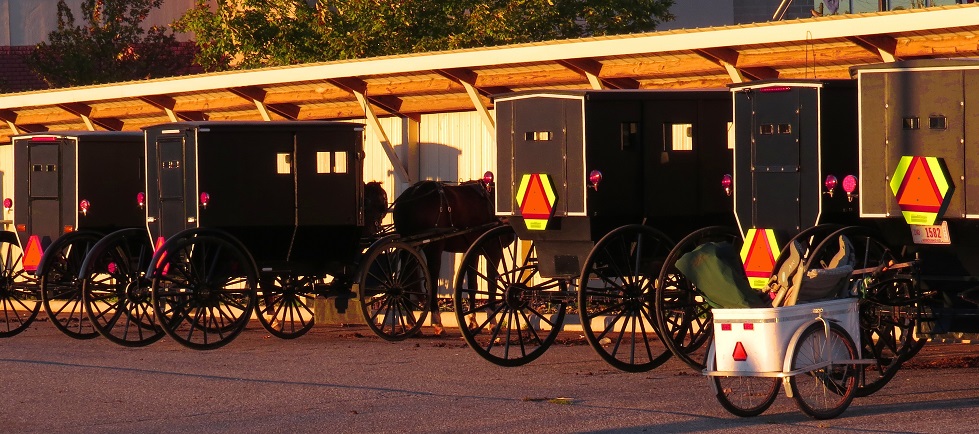 Background information on the modification
Background information on the modification
The intrinsic efficacy of the Tri-Color Triangle ™ is because of the increased visual impact that the product has over the existing SMV emblems and standards. Its more effective impact gives an increased margin of safety for agricultural and construction equipment and horse-drawn equipment operators utilizing it and the motoring public that is exposed to it in traffic. This greater impact comes from adding a new, stimulating color, a larger overall surface area (even more so with the BIG version), more Retro-reflective (referred by laymen as “reflective”) area at night and no difference between daytime and nighttime appearances. With an approximately 1 1/5 times increase in height yielding about a 1 1/2 times increase in total surface area (original T-C Ts), this new emblem is easier to see from a greater distance and occupies a greater percentage of visual real estate at a farther distance than the current standard’s emblem… again, even more so for the BIG version. Modern developments in the practical applications of optics and materials have given us new materials that are both fluorescent and retro-reflective. The very newest retro-reflective materials have been engineered to be substantially more retro-reflective (a higher percentage of candlepower returned). The characteristics of degrees of bounce-back retro-reflectivity have been tweaked to be either narrowly-directional (if needed) or nearly-unidirectional (with proprietary materials from certain manufacturers). These better materials give much more retro-reflected light under challenging circumstances of long distances and angles that would have been physically impossible with yesterday’s old and even today’s engineering-grade strips and still less than ideal even with today’s more common specs and materials. The specification of and use of these very newest materials in this emblem will preclude some of what has plagued older-style emblems for years: relatively poor retro-reflectivity and poor angles of effectiveness. Safety Psychographics is continually pursuing its ability to utilize the most effective materials. We currently utilize Avery-Dennison Omni-Cube ™ sheeting as we find it to be the best so far. We state that the materials used in the T-C T meet or exceed U.S. D.O.T. highway signage standards for durability, fade-resistance and fluorescence, i.e., ASTM D4956-09… and we believe that such standards are sufficient for, if not superior to other standards currently held forth as relevant or “the last word,” flawed and being the result of compromising as they may be. A link to the Avery-Dennison Omni-Cube ™ sheeting that we utilize in making the T-C T is here (you’ll see why we’re pretty sold on it), and links to the various ASTM D4956-09 standards are here. Comparative testing of these materials helps to insure the use of the best materials to be sold to our end users. The utilization of 0.555 μm color of yellow-green and fluorescent, the wavelength most stimulating to the eye in daylight, for the added new outer stripes ensures that that part of the emblem will have the greatest chance of being seen and noticed. The juxtaposition of those stripes with the standard fluorescent orange serves up new contrast to stimulate the eye in a psychographics-principles “dazzling” manner. From “The Perceptive Efficiency of the Human Eye as a Function of Wavelength”: “The efficiency curves for the red and green cones cross (i.e., are exactly equal) for radiation of wavelength about 0.56 μm. When the eye sees 0.56 μm radiation it stimulates the red and green cones about equally. The visual perception of near equal stimulation of the red and green cones is yellowness.” (http://sjsu.edu/faculty/watkins/eye.htm) The consequence from this physiological fact is that this tint of yellow-green color at this specific wavelength is perceived as the brightest color possible. Its inclusion in this new design is in the context of being an additional type of “conspicuity striping” (comparable to what has been required for some years now for the trucking and railroad industries) and will serve to update the hoary SMV emblem for effective modern use. The additional quality of these new stripes being retro-reflective besides fluorescent, along with the change of the center triangle section’s going from currently being strictly fluorescent to also being retro-reflective (both being elements of the T-C T’s copyrighted and patented status) in sum will give the new emblem the quality of appearing the same by night as it does by day. Research in and long-standing familiarity with “visual psychographics” principles (this being the field of the psychological application of graphic design principles as opposed to the “psychological demographics” usage of the word) and relevant aspects of pure and applied optic science, plus longstanding experience in the agricultural transportation field have allowed basic observations and insights to come together to create the concept embodied here. Relatively-new advances in specific highway signage materials deemed fit to utilize for this product (Avery-Dennison OmniCube) have made for a more nearly-ideal combination of concept, design and materials. The agricultural highway transportation, self-propelled construction vehicles and horse-drawn vehicles markets will all benefit, along with the general motoring public in contact with them, from this development as to the greater margin of safety inherent when used properly and as intended. The Tri-Color Triangle ™ has for some time been out of its initial development stage and is for sale. Details on ordering are on this page , with specific local ordering information also given on the BIG T-CT page.
As this product obviously builds upon the basics of the current SMV emblem (not invented by but allowed to be standardized by ASABE), only the new aspects are deemed proprietary. It and its variants are under the protection of having a U.S. Patent as well as also being copyrighted. It cannot be copied (counterfeited) in any size, nor may the design be utilized by others, whether for sale or not, in any manner (including decorative, clothing, advertising or cultural reference purposes) nor may such potential copies, impinging derivations, trade dress infringement attempts nor counterfeits be sold by any other person or manufacturer
*the colloquial, layman’s use of “reflective” and “reflector,” used in various places is actually incorrect. The correct optics and engineering term that should be used is “retro-reflective,” indicating a directional bounce-back of light as opposed to the concept of common objects that are visible being visible from most all angles. Informed engineers and their engineering societies are normally expected to know and use the different terms properly, though this writer had indeed caught himself early-on at times falling back out of unversed habits on the uninformed term “reflective,” and I apologize.
The combination of fluorescent orange and fluorescent yellow-green certainly seems to go together well where visibility is critical.
 The Tri-Color Triangle ™ has been chosen by the American Society of Agricultural and Biological Engineers as one of the 50 most innovative designs in engineering products for agriculture for 2014 (awarded in 2015). Details on this page: https://3triangle.wordpress.com/tri-color-triangle-one-of-the-50-most-innovative-designs-in-engineering-products-for-agriculture/ ————————————————————————
The Tri-Color Triangle ™ has been chosen by the American Society of Agricultural and Biological Engineers as one of the 50 most innovative designs in engineering products for agriculture for 2014 (awarded in 2015). Details on this page: https://3triangle.wordpress.com/tri-color-triangle-one-of-the-50-most-innovative-designs-in-engineering-products-for-agriculture/ ————————————————————————
A Questions and Answers page is now on this site to answer general and specific questions that have been raised by concerned parties about the Tri-Color Triangle ™:

The picture above illustrates how the Tri-Color Triangle ™ compares under flash photography with a conventional SMV emblem (at right) and 2 non-standard triangles (details on this page).
The following are various field testing photographs showing the dramatic increase in visibility of the Tri-Color Triangle ™ as compared to standard SMV emblems.
 equipment example #1 with standard SMV emblem
equipment example #1 with standard SMV emblem  equipment example #1 with Tri-Color Triangle ™ in addition to standard SMV emblem
equipment example #1 with Tri-Color Triangle ™ in addition to standard SMV emblem  equipment example #2 with Tri-Color Triangle ™ in addition to standard SMV emblem
equipment example #2 with Tri-Color Triangle ™ in addition to standard SMV emblem  equipment example #3 with standard SMV emblem
equipment example #3 with standard SMV emblem  equipment example #3 with Tri-Color Triangle ™
equipment example #3 with Tri-Color Triangle ™  equipment example #4 with standard SMV emblem
equipment example #4 with standard SMV emblem  equipment example #4 with Tri-Color Triangle ™
equipment example #4 with Tri-Color Triangle ™  equipment example #5 with standard SMV emblem
equipment example #5 with standard SMV emblem  equipment example #5 with Tri-Color Triangle ™ in addition to standard SMV emblem
equipment example #5 with Tri-Color Triangle ™ in addition to standard SMV emblem
 Tri–Color Triangle ™ Conspicuity is the Key ™ Gotta Go Green… to be Seen ™
Tri–Color Triangle ™ Conspicuity is the Key ™ Gotta Go Green… to be Seen ™
Following are photographs of proper standard emblems, related psychographic design examples and the Tri-Color Triangle ™ in development. 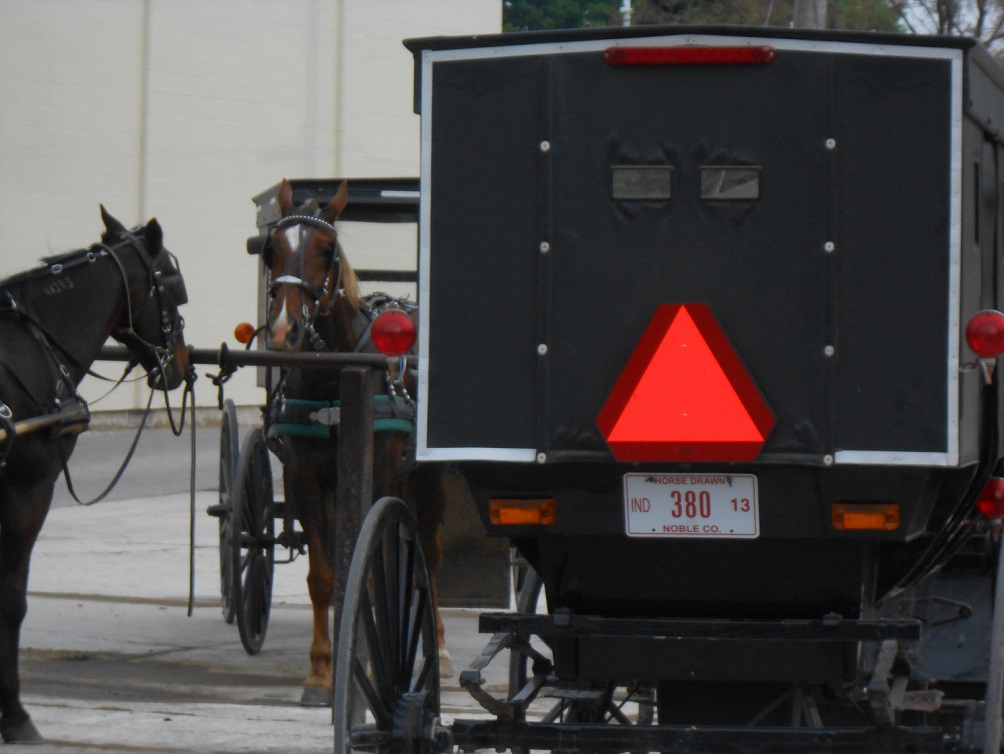 An Amish buggy with an intact, conventional, properly-mounted standard SMV emblem. The fluorescence is bright and up to current legal standards… no reddish-violet plain plastic triangle section here. The only problem is what plagues all current-standard emblems: the single main color–orange–is not quite as eye-catching as such a color may have been back in the 1950s and 1960s when the presence of such type colors was a rarity anywhere. Additionally, orange is closer to the end of the spectrum that is less stimulating to the eye (red even more so and it provides no contrast against the buggy’s black color ). Brown is only a couple of notches away on the color wheel.
An Amish buggy with an intact, conventional, properly-mounted standard SMV emblem. The fluorescence is bright and up to current legal standards… no reddish-violet plain plastic triangle section here. The only problem is what plagues all current-standard emblems: the single main color–orange–is not quite as eye-catching as such a color may have been back in the 1950s and 1960s when the presence of such type colors was a rarity anywhere. Additionally, orange is closer to the end of the spectrum that is less stimulating to the eye (red even more so and it provides no contrast against the buggy’s black color ). Brown is only a couple of notches away on the color wheel.  A buggy with a Tri-Color Triangle ™ prototype. Needless to say, the increase in overall area, visibility and contrast will impart a greater margin of safety to this vulnerable community of people who share the roads with we “English”… who have no desire to unintentionally hit these fragile conveyances for their current relative lack of effective ability to stand out properly in traffic.
A buggy with a Tri-Color Triangle ™ prototype. Needless to say, the increase in overall area, visibility and contrast will impart a greater margin of safety to this vulnerable community of people who share the roads with we “English”… who have no desire to unintentionally hit these fragile conveyances for their current relative lack of effective ability to stand out properly in traffic. 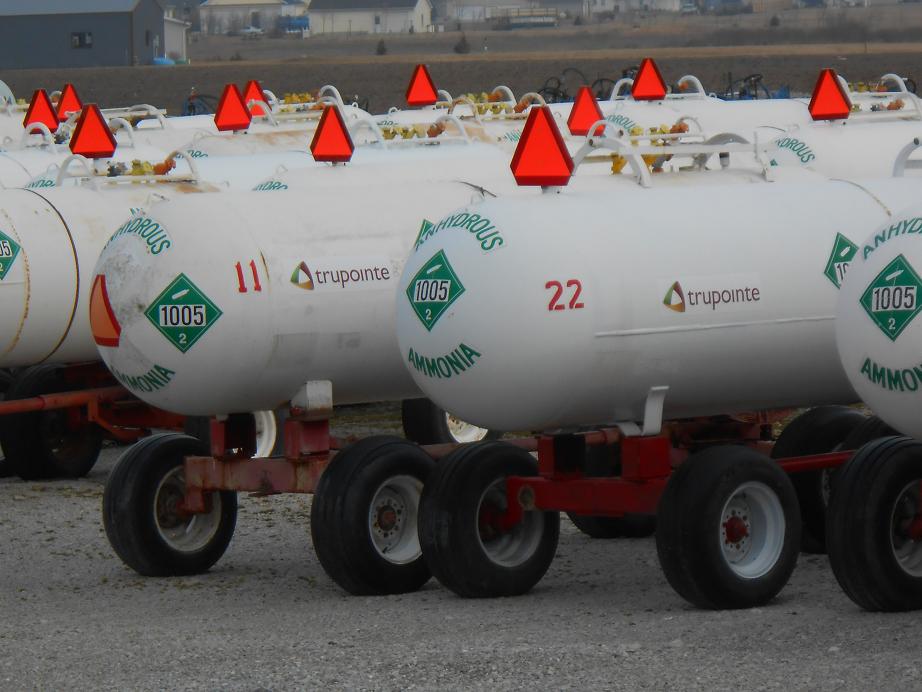 A collection of effective standard emblems mounted on ammonia wagons. This shows yet another mounting position that is an alternative to decals mounted directly on the back of the tank (though one here does feature that).
A collection of effective standard emblems mounted on ammonia wagons. This shows yet another mounting position that is an alternative to decals mounted directly on the back of the tank (though one here does feature that). 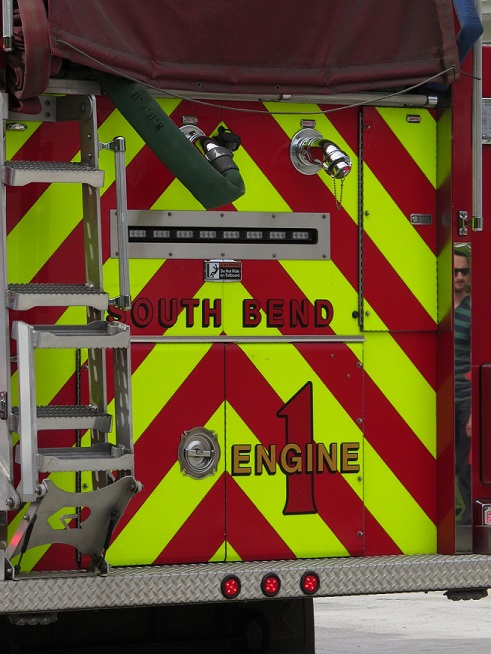 Example #1 of the usage of fluorescent yellow-green stripes on the back of a Michiana fire truck for better visibility.
Example #1 of the usage of fluorescent yellow-green stripes on the back of a Michiana fire truck for better visibility.  Example #2 of the usage of fluorescent yellow-green stripes on the back of another Michiana fire truck for better visibility.
Example #2 of the usage of fluorescent yellow-green stripes on the back of another Michiana fire truck for better visibility.  Example #3 of the usage of fluorescent/retro-reflective yellow-green and fluorescent/retro-reflective orange stripes on the backs of phone company trucks in Michiana for better visibility.
Example #3 of the usage of fluorescent/retro-reflective yellow-green and fluorescent/retro-reflective orange stripes on the backs of phone company trucks in Michiana for better visibility. 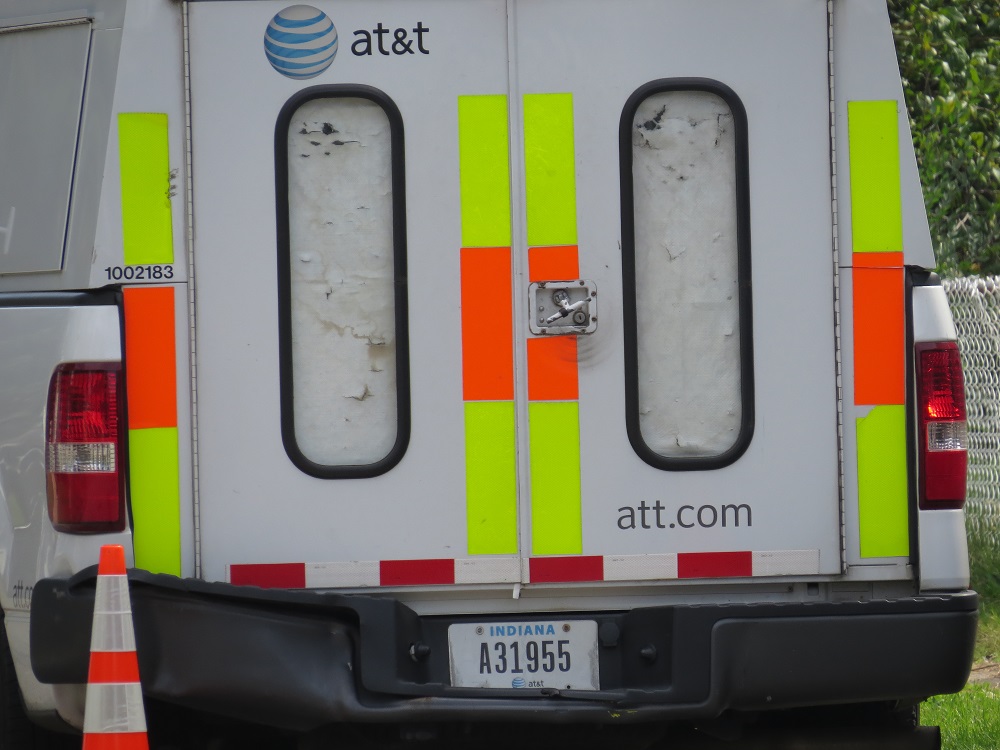 Example #4: close-up of the usage of fluorescent/retro-reflective yellow-green and fluorescent/retro-reflective orange stripes on the back of a phone company truck in Michiana for better visibility.
Example #4: close-up of the usage of fluorescent/retro-reflective yellow-green and fluorescent/retro-reflective orange stripes on the back of a phone company truck in Michiana for better visibility. 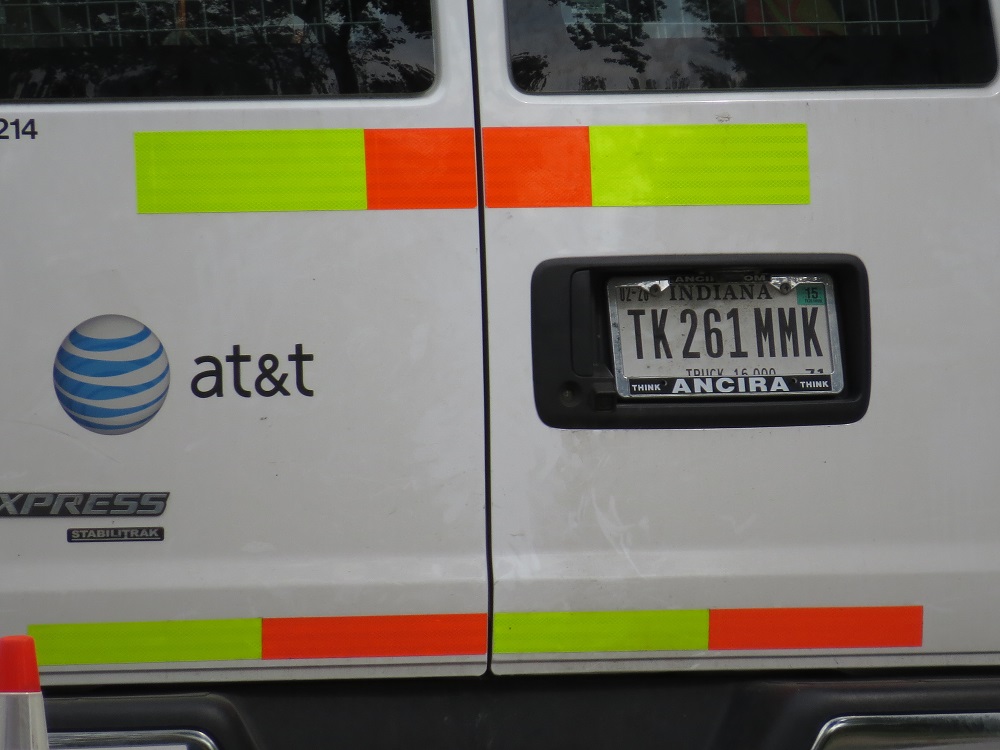 Example #5: another close-up of the usage of fluorescent/retro-reflective yellow-green and fluorescent/retro-reflective orange stripes on the back of another phone company truck in Michiana for better visibility.
Example #5: another close-up of the usage of fluorescent/retro-reflective yellow-green and fluorescent/retro-reflective orange stripes on the back of another phone company truck in Michiana for better visibility. 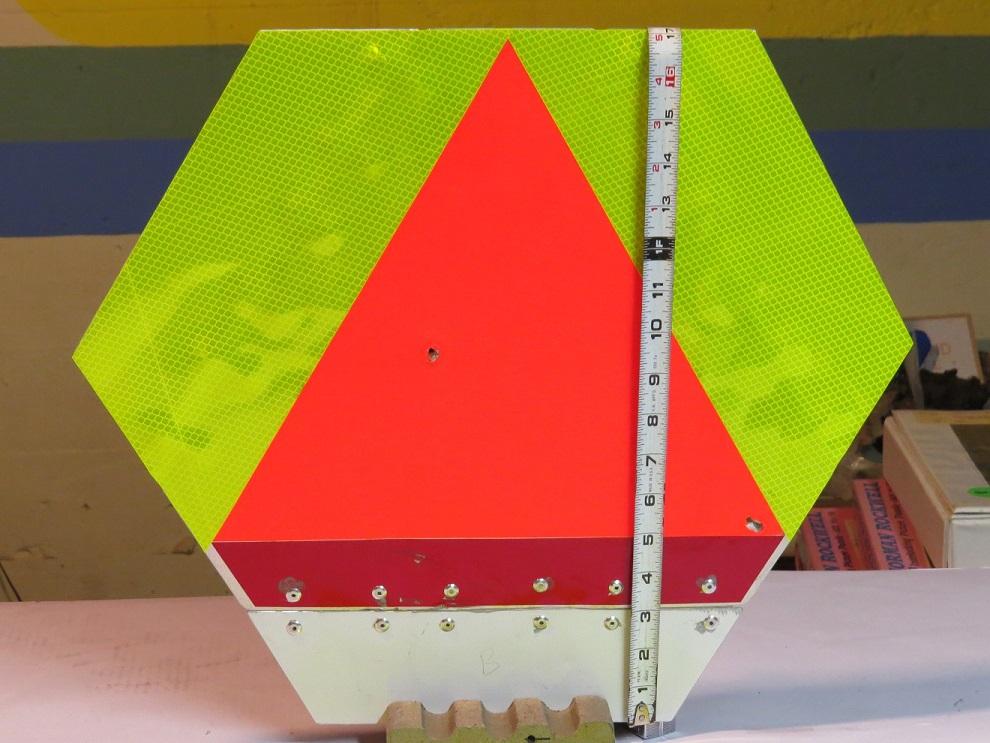 The second prototype of the Tri-Color Triangle ™ under construction when it was being envisioned as just a 2-color triangle: orange and yellow-green.
The second prototype of the Tri-Color Triangle ™ under construction when it was being envisioned as just a 2-color triangle: orange and yellow-green.  The first iteration of the 2nd prototype, at right, when it was just a bi-colored triangle. Though this design is still thought by myself to be a ‘purer’ and more visible upgrade to the standard emblem for its greater area of yellow-green, it was later suggested that perhaps the standard emblem’s red stripes were still needed because some motorists would possibly not make the connection between the old style and the new. This intermediate stage’s design is still copyrighted. Another different, earlier test version of a possible emblem upgrade is shown at the left.
The first iteration of the 2nd prototype, at right, when it was just a bi-colored triangle. Though this design is still thought by myself to be a ‘purer’ and more visible upgrade to the standard emblem for its greater area of yellow-green, it was later suggested that perhaps the standard emblem’s red stripes were still needed because some motorists would possibly not make the connection between the old style and the new. This intermediate stage’s design is still copyrighted. Another different, earlier test version of a possible emblem upgrade is shown at the left.  In the engineering sign shop late in the game awaiting the last sample sheeting from the manufacturer with the brightest, most retro-reflective material. This material is to be retro-reflective from the widest angle available and the brightest head-on; a competing manufacturer complained that it was “too bright and retro-reflective.” The brighter and more retro-reflective will do just fine for this in-motion safety product usage. Red and fluorescent/retro-reflective orange samples seen at rear.
In the engineering sign shop late in the game awaiting the last sample sheeting from the manufacturer with the brightest, most retro-reflective material. This material is to be retro-reflective from the widest angle available and the brightest head-on; a competing manufacturer complained that it was “too bright and retro-reflective.” The brighter and more retro-reflective will do just fine for this in-motion safety product usage. Red and fluorescent/retro-reflective orange samples seen at rear.
-30-


